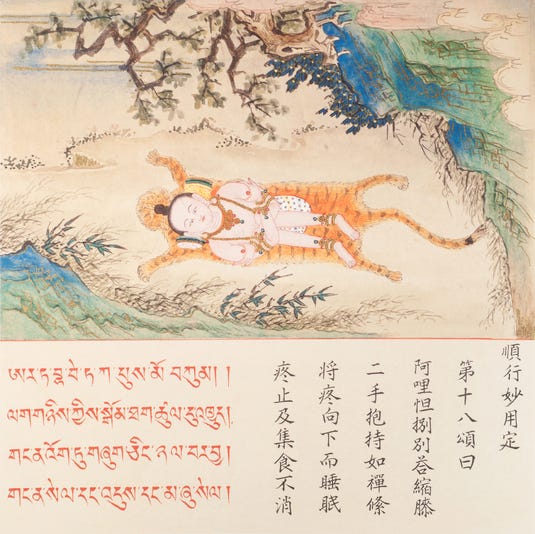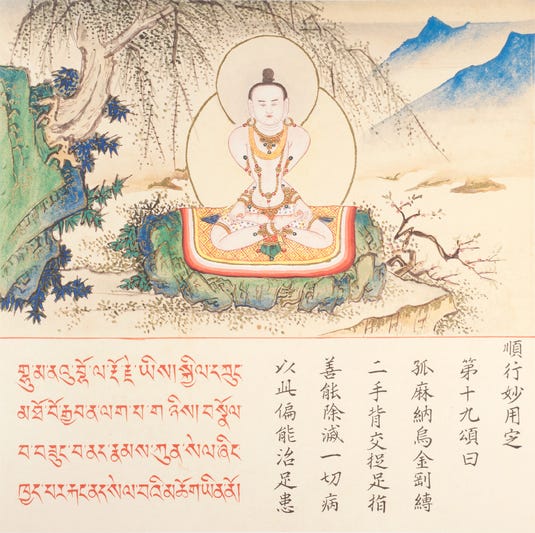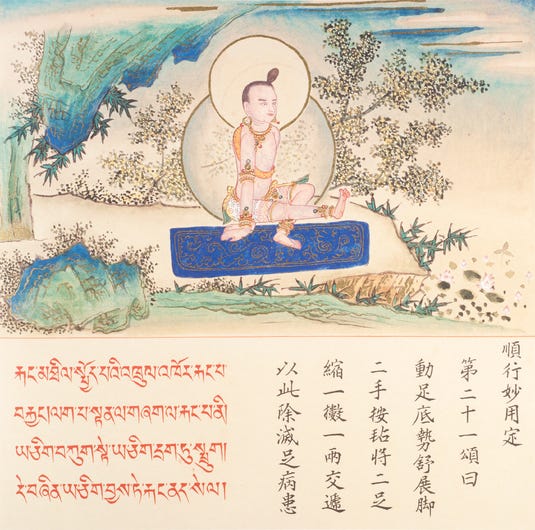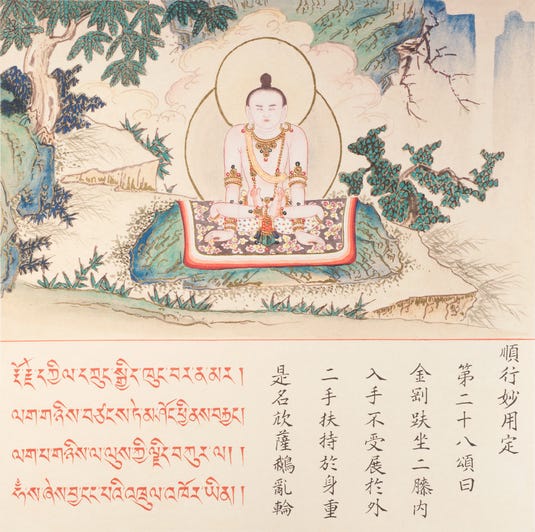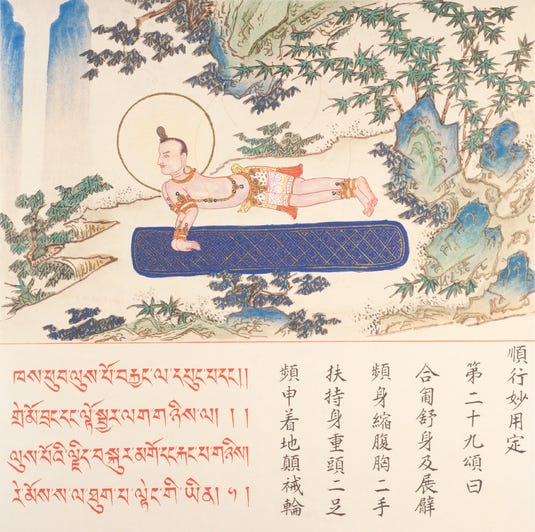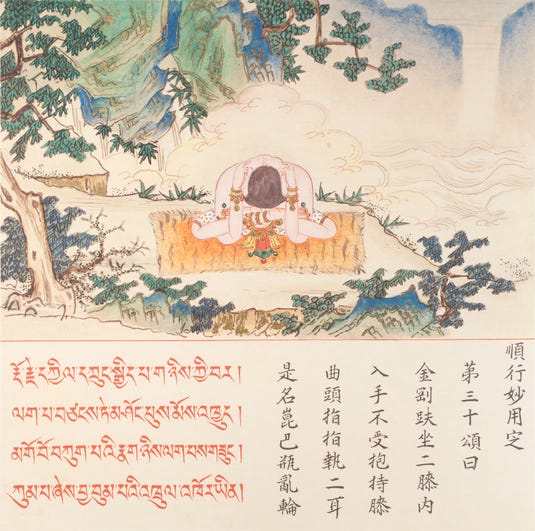Notes
[རྣལ་འབྱོར་གྱི་འཕྲིན་ལས་སོ་གཉིས་ཀྱི་འཁྲུལ་འཁོར་] The thirty-two yogic trulkhor is one of the best-known trulkhor practices of the Sakya Lamdrepa. There are a few different versions of this trulkhor practice in the Sakya Lamdre texts. One is attributed to Phagmo Drupa Dorje Gyalpo [12th century] whose trulkhor instructions are quite different and brief. This translation is based on the text composed by Lama Dampa Sonam Gyaltsen [14th century]. It was later edited by Jamgon Anye zhab Kunga Sonam [17th century].
The images of the trulkhors shown in this article are from the thirty-two trulkhor practices of the Sakya Lamdrepa, which can be found in the Palace Museum in Beijing. According to the Himalaya Art Resource website, 'The images are a Qianlong period text copied from a Yuan period publication'. Here is the link to the website where you can see all the images.
Almost all the names of the trulkhors in this text have Sanskrit names which are transliterated into Tibetan, many of which are difficult to decipher and understand. Different texts give different spellings. Here are some notes on the trulkhors.
The vajra cross-legged posture is commonly known as the full lotus in the Hindu tradition.
The 28th is commonly known as the Rooster pose [kukkutasana] in the Hindu tradition. This posture is called Swan [Haṃsa] here. This posture is quite common in Vajrayana.
The 29th is little bit similar to Peacock pose [Mayurasana] in the Hindu tradition. This posture is called ḍēṅgī [which could mean prop] in this text.
The 30th and the 31st is similar to Uttana kurmasana or Garbha pindasana of Hindu tradition, which is called kumbha and Kurma respectively in this text.
Trulkhors in this practice generally begins and ends with a specific breathing technique. [I think] it starts with: “Crossing arms over the chest [with the vajra fist placed on the opposite breast], [first] blow out the residual harmful air, [then inhale and press down the upper air] and hold the union of the upper and lower air.” And it ends with: "Crossing the arms over the chest and let the air out.”
PS: This post contains the translation of the remaining half of the text. To see the previous half of the text, click on this link.
Text and Translation
17. Aprasara-2 [ཨ་པར་ས་ར་]
ཨ་པར་ས་ར་སྐྱིལ་ཀྲུང་བདེ་བར་བཅས། །ལག་གཉིས་བརྩེགས་པས་ལྟག་པའི་ཕྱོགས་སུ་་དགབ༑ །གྲེ་མོ་མདུན་དུ་མི་གུག་ལུས་ལྗིད་བསྐུར། །མགོ་ནད་ལུས་དང་མ་ཞུ་སྐྱུགས་པ་སེལ༑
Sit in the vajra crossed-legged posture. Place your left hand [palm down] on the back of your neck and your right hand on top of the other. With your hands firmly touching the back of your neck, extend your elbows directly [to the side] without bending them forward. Then rub [skt. mardana] the back of your neck from side to side.
Benefits: This eliminates the headache, indigestion and nausea.
18. Artabhaveta/Ārdha-Bhautika1 [ཨརྟ་བྷ་ཝེ་ཏ་ཀ་]
ཨར་ཏ་བྷ་ཝེ་ཏ་ཀ་པུས་མོ་བསྐུམ། །ལག་པ་གཉིས་ཀྱི་སྒོམ་ཐག་ཚུལ་དུ་འཁྱུད། །གང་ན་འོག་ཏུ་གཞུག་ཅིང་ཉལ་བར་བྱ། །གང་ན་བ་དང་འདུས་པ་མ་ཞུ་སེལ།
[In the squatting position], wrap your arms around your bent knees like a yoga belt. Then, without losing that posture, lie down on the front, back, right or left side of your back, especially where the ailment is [until the sensation of numbness occurs].
Benefits: This will remove the pain or problem wherever it is.
19. Ghumanaupala/Ghumanaubhola [གྷུ་མ་ནའུ་པ་ལ་/གྷུ་མ་ནའུ་བྷོ་ལ་]
གྷུ་མ་ནའུ་པ་ལ་རྡོ་རྗེ་ཡི། །སྐྱིལ་ཀྲུང་མཐེ་བོང་རྒྱབ་ནས་ལག་པ་གཉིས། །བསྣོལ་ནས་བཟུང་བས་ནད་རྣམས་ཀུན་སེལ་ཞིང་། །ཁྱད་པར་རྐང་ནད་སེལ་བའི་མཆོག་ཡིན་ནོ༑
In the vajra crossed-legged posture, bring the right hand behind your back and hold the right big toe. Bring the left hand behind your back and hold the left big toe. Then straighten the spine.
Benefits: This is the best way to relieve leg pain.
20. Ganga-Caurangi/Gagana-caurangi [གཾ་ག་ཙོོ་རཾ་གི་/ག་ག་ན་ཙོ་རང་གི་]
གོ་ག་ཙོ་རཾ་གི་ནི་སྐྱིལ་ཀྲུང་སྟེ། །རྡོ་རྗེ་བསྡམས་པའི་གུང་མོ་བརྐྱངས་ལ་སྦྱར། །ལྡོག་པ་སྤྱི་བོའི་སྟེང་བཙུག་ཁ་མིག་བགྲད། །ལྟོ་བཅེར་ཁ་སྦྱོར་རླུང་སྐྱོན་ཐམས་ཅད་སེལ།
In the vajra crossed-legged posture, interlock the fingers except for the tips of the middle fingers, which touch each other. With the hands upside down, place the tips of the middle fingers on the top of the head. With the mouth and eyes wide apart, press the abdomen against the spine.
Benefits: This eliminates all the problems of the vital air.
21. རྐང་མཐིལ་སྤྱོད་པའི་འཁྲུལ་འཁོར་/རྐང་མཐིལབསྐྱོད་པའི་འཁྲུལ་འཁོར་2 [Movement of the soles of the feet]
རྐང་མཐིལ་སྤྱོད་པའི་འཁྲུལ་འཁོར་རྐང་པ་བརྐྱང་། ལག་པ་སྟན་ལ་བཞག་ལ་རྐང་པ་ནི། །ཡ་གཅིག་བཀུག་སྟེ་ཡ་གཅིག་དྲག་ཏུ་སྤྲུག །དེ་བཞིན་ཡ་གཅིག་བྱས་ཏེ་རྐང་ནད་སེལ།
Dismantle the vajra crossed legs by throwing the legs onto the seat. Then plant your hands and feet on the ground and lift your buttocks off the ground. In this posture, extend and bend your right leg [in the air], and while you are bending your leg, strike your right heel against your buttocks. Do this three times. Then place your right foot back on the ground and, in the same way, extend your left leg and strike your left heel against your buttocks three times.
Benefits: Relieves leg pain.
22, 23, 24, 25 and 26. ཡན་ལག་ལྔ་སྦྱོང་ [Five limbs of the body practice]
དེ་ནས་ཡན་ལག་ལྔའི་སྦྱོང་བ་ནི། མགོ་བོ་མཇིང་པ་བསྒྱུར་ལ་ལག་གཉིས་གཡབ། །སྐྱིལ་ཀྲུང་ལག་པས་མནན་ལ་ལུས་པོ་གཅུ། །རྐང་པ་གཉིས་ཀྱང་མདུན་རྒྱབ་དྲག་ཏུ་སྤྲུག།
22. Head:
Rotate your head clockwise and counterclockwise three times, bend your head forward and backward three times, and bend your head to the right and left three times.
23. and 24. Right Arm and Left Arm:
Circle your right hand counter-clockwise above your head and extend it to your right side. Do this three times. Circle your left hand clockwise above your head and extend it to your left side. Do this three times. Place your left hand on your chest, extend your right arm and bring your right hand over your shoulder and strike with your hand. Do this three times. Then place your right hand on your chest, stretch out your left arm and bend your arms, striking your left shoulder with your hand. Do this three times. Then circle both your hands above your head [at the same time] and stretch both to the left and to the right. In all cases, as you extend your arms, extend your fingers as well. Then cover your knees with the palms of your hands. Without lifting your buttocks from the floor, bring your right shoulder to your left knee and your left shoulder to your right knee. Do each of these three times. If you cannot hold your breath, let the air out slowly.
25. and 26. Right Leg and Left Leg:
After holding the [Kumbhaka] breath, stand up and cross your arms over your chest. Then shake your right leg forward three times. Shake your left leg backwards three times. Then shake your right leg backwards three times and your left leg forward three times. Next, rub your right foot along the calf of your left leg, when it reaches your left knee, turn your right foot in a circle to the right where your right knee is bent. Then shake your right leg, stretching it opposite the left knee. In the same manner, rub your left foot along the calf of your right left leg and when it reaches the right knee, turn your left foot in a circle to the left where your left knee remains bent. Then shake your left leg, stretching it opposite the right knee. Do each of these three times. Next, sit down in a vajra crossed-legged posture with arms crossed over the chest. Then let the air out slowly.
27. Haṃsa-Pakṣa [ཧཾ་ས་པཀྴི་]
ཧཾ་ས་པཀྴི་ལག་གཉིས་རྐང་པ་ཡི། །ནང་དུ་བཅུག་ལ་རྐང་པ་བསྐུམས་ནས་ནི། །ལག་པ་གཉིས་ལ་ལུས་ཀྱི་ལྗིད་བསྐུར་བ། །ངང་པའི་གཤོག་པ་ལྟ་བུའི་འཁྲུལ་འཁོར་ཡིན།
Bring your hands inside your thighs and place them side by side on the ground. Then straighten your elbows and lift your bent legs close to your elbows by putting the weight of your body on your hands, and remain in this position, keeping your legs bent. This is a swan's wing like the trulkhor.
28. Haṃsa [ཧཾ་ས་]
རྡོ་རྗེ་སྐྱིལ་ཀྲུང་སྒྱིད་ཁུག་བར་ན་མར། །ལག་གཉིས་བཅུག་སྟེ་མ་ཤོངས་ཕྱི་ནས་ཀྱང་། །ལག་པ་གཉིས་ལ་ལུས་ཀྱི་ལྗིད་བསྐུར་བ། །ཧཾ་ས་ཞེས་པ་་ངང་པའི་འཁྲུལ་འཁོར་ཡིན།
In the vajra crossed-legged posture, pass the hands through the knees and place the hands on the ground. Putting the weight of your body on your hands, lift the crossed legs and remain in this position.
29. ḍēṅgī [ཌེཾ་གི་]
ཁ་སྦུབས་ལུས་པོ་བརྐྱངས་པའི་དཔུང་པ་དང་། །གྲུ་མོ་བྲང་ལ་ལྟོ་སྦྱར་ལག་གཉིས་ལ། །ལུས་ཀྱི་ལྗིད་བསྐུར་མགོ་དང་རྐང་པ་གཉིས། །རེས་མོས་ས་ལ་ཐུག་པ་ཌེཾ་གི་ཡིན།
From the vajra cross-legged posture with the fists on the thighs, uncross the legs, throw them to the ground and stand up. Place the hands close together on the ground. Bring the elbows to the chest and place the body weight on the elbows. Extend legs backwards and lift them up. Your forehead should just touch the ground. Then lift your forehead off the floor and let your feet just touch the floor. Do this three times.
30. Kumbha [ཀུམ་པ་]
རྡོ་རྗེ་སྐྱིལ་ཀྲུང་སྒྱིད་པ་གཉིས་ཀྱི་བར། །ལག་པ་བཙང་སྟེ་མ་ཤོངས་པུས་མོར་འཁྱུད། །མགོ་བོ་བཀུག་པའི་རྣ་བ་ལག་པས་གཟུང་། །ཀུམ་པ་ཞེས་བྱ་བུམ་པའི་འཁྲུལ་འཁོར་ཡིན༑
Sit in a vajra cross-legged posture. Pass your hands through the knee-pits (inside the crossed legs). Bend down your head and hold the ears with your hands.
31. Kurma [ཀུརྨ་]
Sit in a vajra cross-legged posture. Now pass your hands through the knee-pits (inside the crossed legs). Bend your head down, and join your hands together at the back of your neck.
32. སེང་གེ་རྣམ་གྲོལ་/སེང་གེ་རྣམ་རོལ་ [Lion’s play/Lion liberation]
སེང་གེ་རྣམ་གྲོལ་དག་དང་སུམ་ཅུ་གཉིས། །དེ་ལྟར་དེ་དག་ཀུན་ལ་ཁ་སྦྱར་ཏེ། །དམིགས་ཀྱིས་བསྟན་པ་དག་ནི་མ་གཏོགས་སོ།
Lion liberation mudra is: In the vajra crossed-legged posture, close the mouth with the little and ring fingers, the nose with the middle fingers, the eyes with the index fingers and the ears with the thumbs.
In another Sakya Lamdre text, this trulkhor [ཨར་ཏ་བྷ་ཝེ་ཏ་ཀ་] is called ལུས་ཕྱེད་ཀྱི་སྦྱོར་བ་, which means yoga or method of the half-body. So I thought the Sanskrit term Ardha-bhautika made more sense.
In another text, it is written as རྐང་མཐིལབསྐྱོད་པ. This trulkhor does not have Sanskrit name.




